Impact of Financial & Non-Financials on Business Decision-Making
VerifiedAdded on 2023/06/10
|7
|1305
|397
Report
AI Summary
This report delves into the critical aspects of business decision-making, focusing on both financial and non-financial factors using the case of Akwaaba plc and their project selections. It evaluates the payback period and net present value (NPV) of two projects—Bags and Shoes—to determine the optimal investment strategy. The analysis reveals that while the Shoes project has a faster payback period, the Bags project boasts a higher NPV, leading to conflicting recommendations based on the chosen method. Beyond these financial metrics, the report explores various financial considerations like cost of capital, uncertainty about monetary inflows, and the availability of funds, alongside non-monetary aspects such as state fiscal regulations, management's risk attitude, technological advancements, and competition. It emphasizes that effective decision-making requires a holistic approach, balancing quantitative analysis with qualitative judgment to align with the company's strategic objectives.

Business decision
making
making
Paraphrase This Document
Need a fresh take? Get an instant paraphrase of this document with our AI Paraphraser
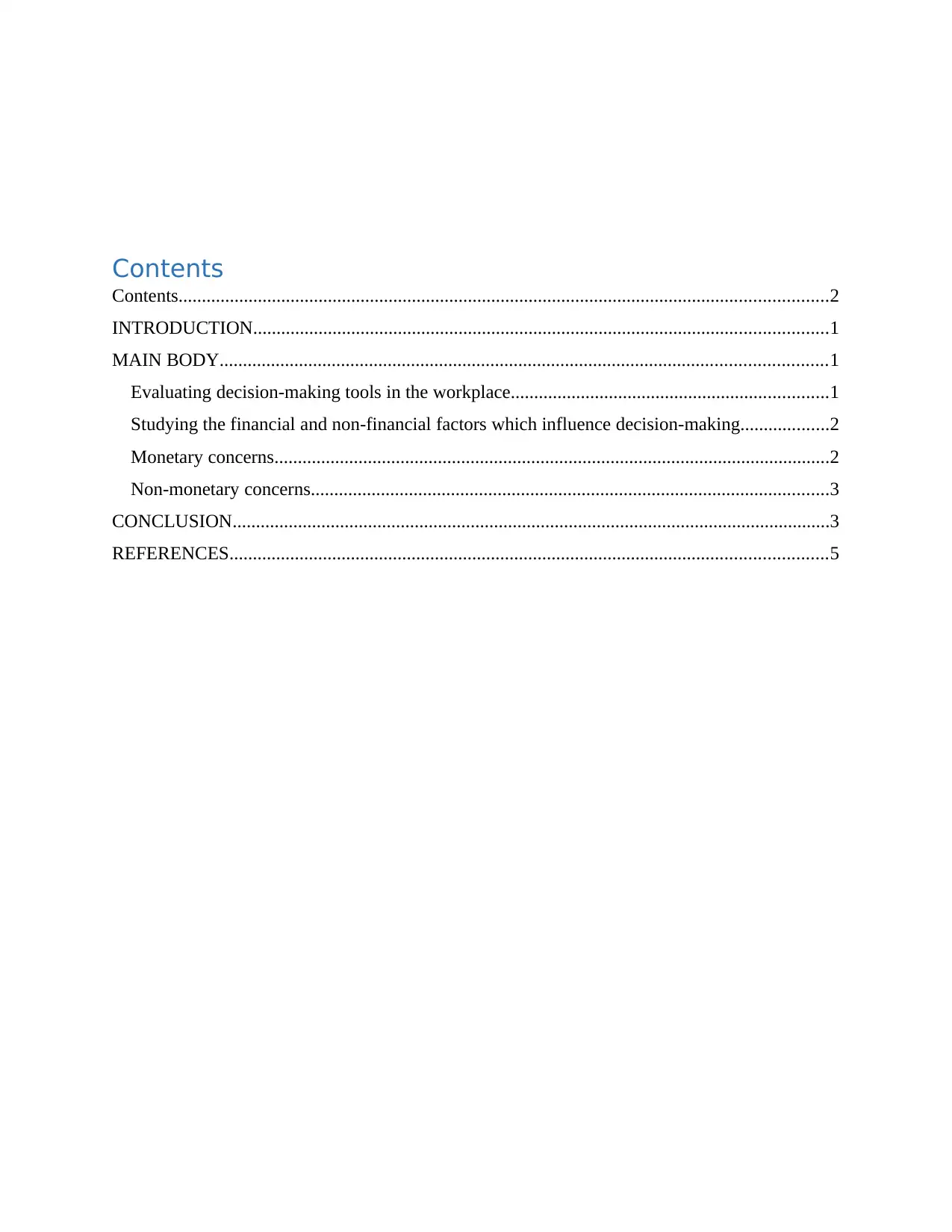
Contents
Contents...........................................................................................................................................2
INTRODUCTION...........................................................................................................................1
MAIN BODY..................................................................................................................................1
Evaluating decision-making tools in the workplace....................................................................1
Studying the financial and non-financial factors which influence decision-making...................2
Monetary concerns.......................................................................................................................2
Non-monetary concerns...............................................................................................................3
CONCLUSION................................................................................................................................3
REFERENCES................................................................................................................................5
Contents...........................................................................................................................................2
INTRODUCTION...........................................................................................................................1
MAIN BODY..................................................................................................................................1
Evaluating decision-making tools in the workplace....................................................................1
Studying the financial and non-financial factors which influence decision-making...................2
Monetary concerns.......................................................................................................................2
Non-monetary concerns...............................................................................................................3
CONCLUSION................................................................................................................................3
REFERENCES................................................................................................................................5
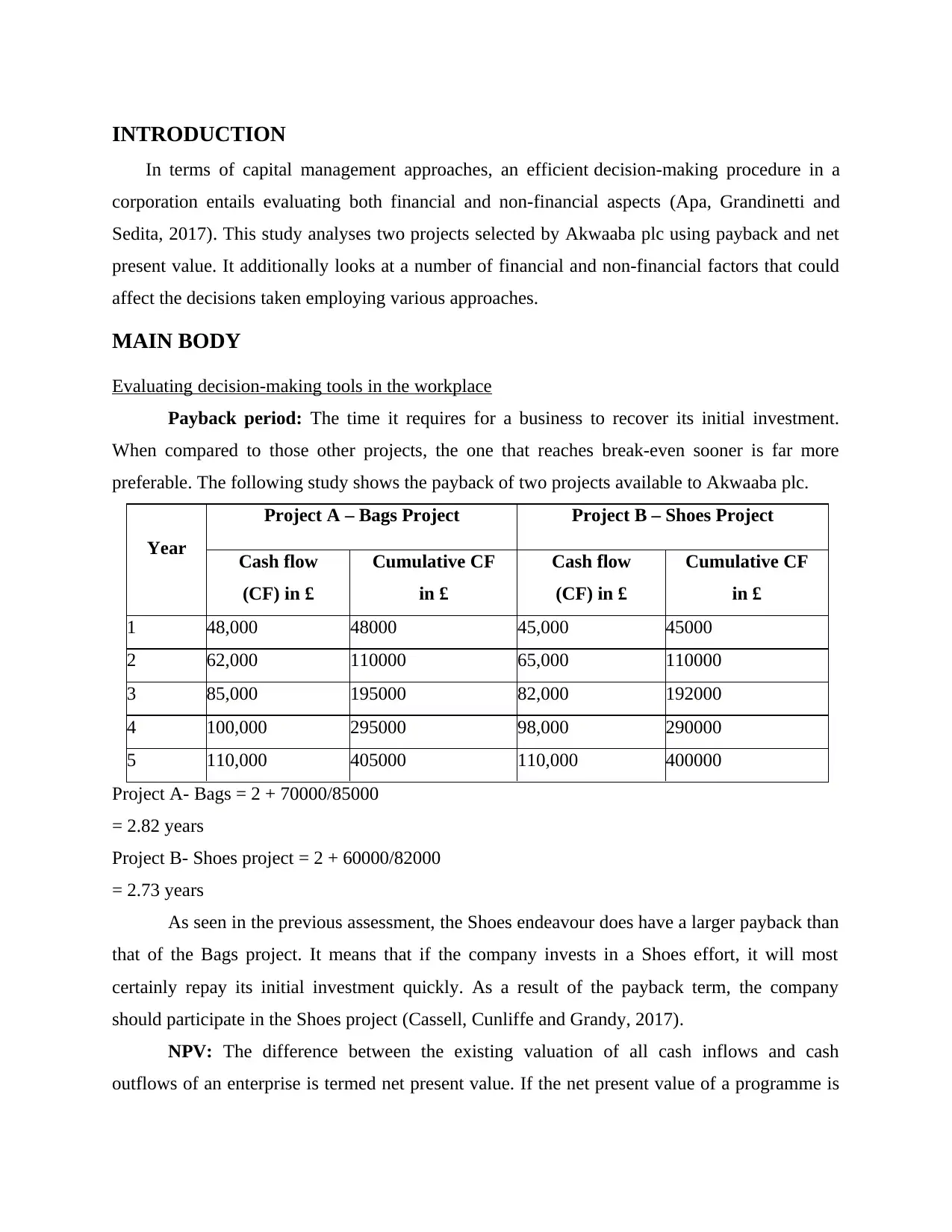
INTRODUCTION
In terms of capital management approaches, an efficient decision-making procedure in a
corporation entails evaluating both financial and non-financial aspects (Apa, Grandinetti and
Sedita, 2017). This study analyses two projects selected by Akwaaba plc using payback and net
present value. It additionally looks at a number of financial and non-financial factors that could
affect the decisions taken employing various approaches.
MAIN BODY
Evaluating decision-making tools in the workplace
Payback period: The time it requires for a business to recover its initial investment.
When compared to those other projects, the one that reaches break-even sooner is far more
preferable. The following study shows the payback of two projects available to Akwaaba plc.
Year
Project A – Bags Project Project B – Shoes Project
Cash flow
(CF) in £
Cumulative CF
in £
Cash flow
(CF) in £
Cumulative CF
in £
1 48,000 48000 45,000 45000
2 62,000 110000 65,000 110000
3 85,000 195000 82,000 192000
4 100,000 295000 98,000 290000
5 110,000 405000 110,000 400000
Project A- Bags = 2 + 70000/85000
= 2.82 years
Project B- Shoes project = 2 + 60000/82000
= 2.73 years
As seen in the previous assessment, the Shoes endeavour does have a larger payback than
that of the Bags project. It means that if the company invests in a Shoes effort, it will most
certainly repay its initial investment quickly. As a result of the payback term, the company
should participate in the Shoes project (Cassell, Cunliffe and Grandy, 2017).
NPV: The difference between the existing valuation of all cash inflows and cash
outflows of an enterprise is termed net present value. If the net present value of a programme is
In terms of capital management approaches, an efficient decision-making procedure in a
corporation entails evaluating both financial and non-financial aspects (Apa, Grandinetti and
Sedita, 2017). This study analyses two projects selected by Akwaaba plc using payback and net
present value. It additionally looks at a number of financial and non-financial factors that could
affect the decisions taken employing various approaches.
MAIN BODY
Evaluating decision-making tools in the workplace
Payback period: The time it requires for a business to recover its initial investment.
When compared to those other projects, the one that reaches break-even sooner is far more
preferable. The following study shows the payback of two projects available to Akwaaba plc.
Year
Project A – Bags Project Project B – Shoes Project
Cash flow
(CF) in £
Cumulative CF
in £
Cash flow
(CF) in £
Cumulative CF
in £
1 48,000 48000 45,000 45000
2 62,000 110000 65,000 110000
3 85,000 195000 82,000 192000
4 100,000 295000 98,000 290000
5 110,000 405000 110,000 400000
Project A- Bags = 2 + 70000/85000
= 2.82 years
Project B- Shoes project = 2 + 60000/82000
= 2.73 years
As seen in the previous assessment, the Shoes endeavour does have a larger payback than
that of the Bags project. It means that if the company invests in a Shoes effort, it will most
certainly repay its initial investment quickly. As a result of the payback term, the company
should participate in the Shoes project (Cassell, Cunliffe and Grandy, 2017).
NPV: The difference between the existing valuation of all cash inflows and cash
outflows of an enterprise is termed net present value. If the net present value of a programme is
⊘ This is a preview!⊘
Do you want full access?
Subscribe today to unlock all pages.

Trusted by 1+ million students worldwide
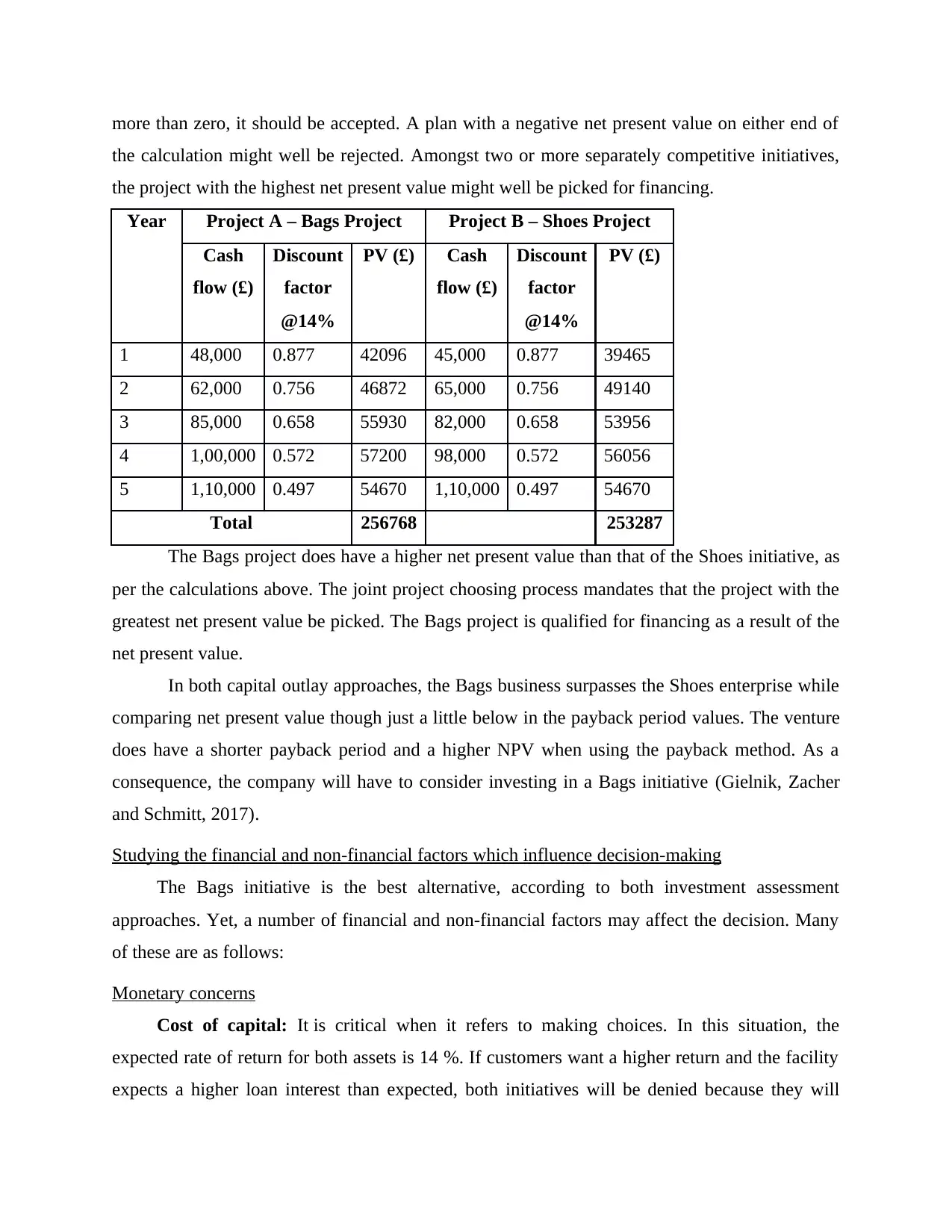
more than zero, it should be accepted. A plan with a negative net present value on either end of
the calculation might well be rejected. Amongst two or more separately competitive initiatives,
the project with the highest net present value might well be picked for financing.
Year Project A – Bags Project Project B – Shoes Project
Cash
flow (£)
Discount
factor
PV (£) Cash
flow (£)
Discount
factor
PV (£)
@14% @14%
1 48,000 0.877 42096 45,000 0.877 39465
2 62,000 0.756 46872 65,000 0.756 49140
3 85,000 0.658 55930 82,000 0.658 53956
4 1,00,000 0.572 57200 98,000 0.572 56056
5 1,10,000 0.497 54670 1,10,000 0.497 54670
Total 256768 253287
The Bags project does have a higher net present value than that of the Shoes initiative, as
per the calculations above. The joint project choosing process mandates that the project with the
greatest net present value be picked. The Bags project is qualified for financing as a result of the
net present value.
In both capital outlay approaches, the Bags business surpasses the Shoes enterprise while
comparing net present value though just a little below in the payback period values. The venture
does have a shorter payback period and a higher NPV when using the payback method. As a
consequence, the company will have to consider investing in a Bags initiative (Gielnik, Zacher
and Schmitt, 2017).
Studying the financial and non-financial factors which influence decision-making
The Bags initiative is the best alternative, according to both investment assessment
approaches. Yet, a number of financial and non-financial factors may affect the decision. Many
of these are as follows:
Monetary concerns
Cost of capital: It is critical when it refers to making choices. In this situation, the
expected rate of return for both assets is 14 %. If customers want a higher return and the facility
expects a higher loan interest than expected, both initiatives will be denied because they will
the calculation might well be rejected. Amongst two or more separately competitive initiatives,
the project with the highest net present value might well be picked for financing.
Year Project A – Bags Project Project B – Shoes Project
Cash
flow (£)
Discount
factor
PV (£) Cash
flow (£)
Discount
factor
PV (£)
@14% @14%
1 48,000 0.877 42096 45,000 0.877 39465
2 62,000 0.756 46872 65,000 0.756 49140
3 85,000 0.658 55930 82,000 0.658 53956
4 1,00,000 0.572 57200 98,000 0.572 56056
5 1,10,000 0.497 54670 1,10,000 0.497 54670
Total 256768 253287
The Bags project does have a higher net present value than that of the Shoes initiative, as
per the calculations above. The joint project choosing process mandates that the project with the
greatest net present value be picked. The Bags project is qualified for financing as a result of the
net present value.
In both capital outlay approaches, the Bags business surpasses the Shoes enterprise while
comparing net present value though just a little below in the payback period values. The venture
does have a shorter payback period and a higher NPV when using the payback method. As a
consequence, the company will have to consider investing in a Bags initiative (Gielnik, Zacher
and Schmitt, 2017).
Studying the financial and non-financial factors which influence decision-making
The Bags initiative is the best alternative, according to both investment assessment
approaches. Yet, a number of financial and non-financial factors may affect the decision. Many
of these are as follows:
Monetary concerns
Cost of capital: It is critical when it refers to making choices. In this situation, the
expected rate of return for both assets is 14 %. If customers want a higher return and the facility
expects a higher loan interest than expected, both initiatives will be denied because they will
Paraphrase This Document
Need a fresh take? Get an instant paraphrase of this document with our AI Paraphraser
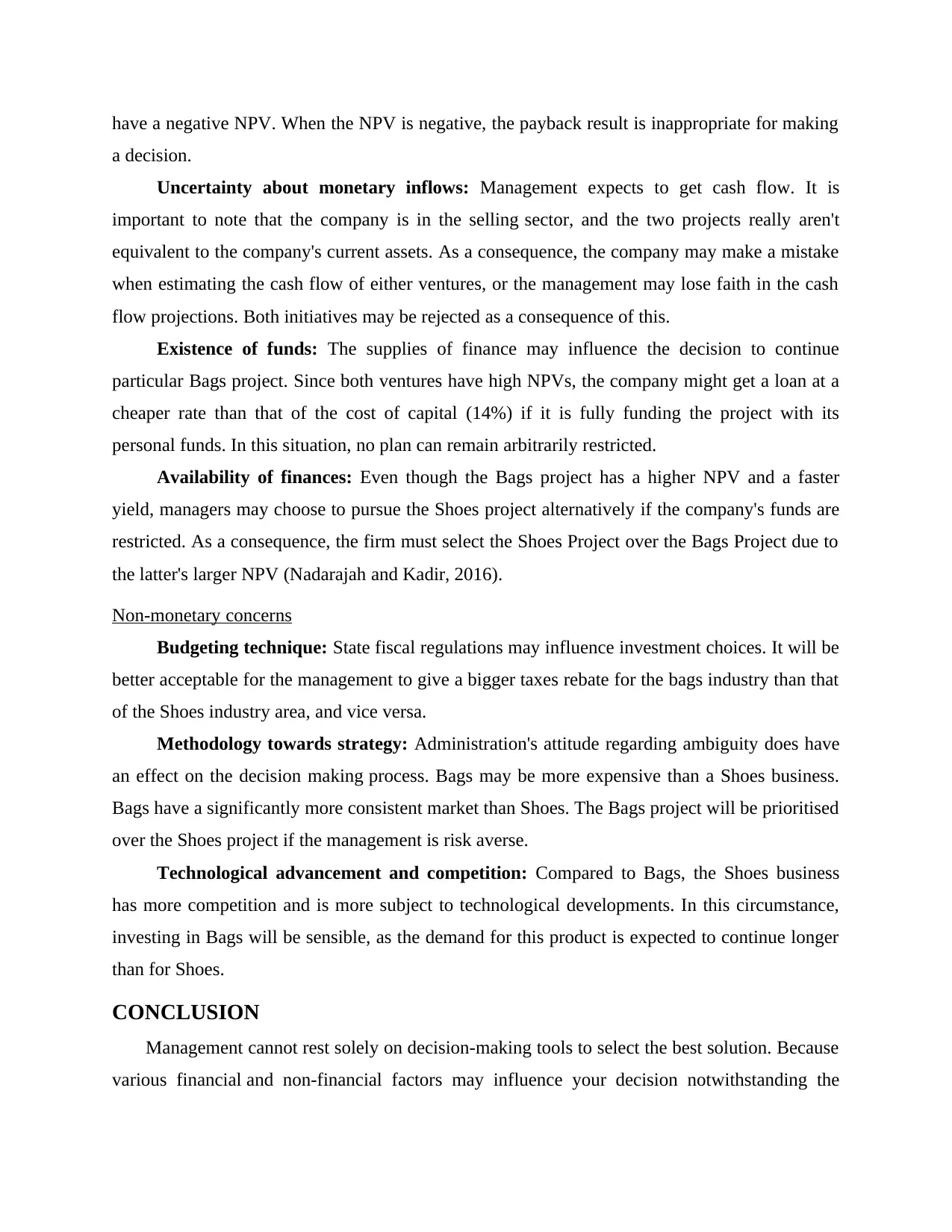
have a negative NPV. When the NPV is negative, the payback result is inappropriate for making
a decision.
Uncertainty about monetary inflows: Management expects to get cash flow. It is
important to note that the company is in the selling sector, and the two projects really aren't
equivalent to the company's current assets. As a consequence, the company may make a mistake
when estimating the cash flow of either ventures, or the management may lose faith in the cash
flow projections. Both initiatives may be rejected as a consequence of this.
Existence of funds: The supplies of finance may influence the decision to continue
particular Bags project. Since both ventures have high NPVs, the company might get a loan at a
cheaper rate than that of the cost of capital (14%) if it is fully funding the project with its
personal funds. In this situation, no plan can remain arbitrarily restricted.
Availability of finances: Even though the Bags project has a higher NPV and a faster
yield, managers may choose to pursue the Shoes project alternatively if the company's funds are
restricted. As a consequence, the firm must select the Shoes Project over the Bags Project due to
the latter's larger NPV (Nadarajah and Kadir, 2016).
Non-monetary concerns
Budgeting technique: State fiscal regulations may influence investment choices. It will be
better acceptable for the management to give a bigger taxes rebate for the bags industry than that
of the Shoes industry area, and vice versa.
Methodology towards strategy: Administration's attitude regarding ambiguity does have
an effect on the decision making process. Bags may be more expensive than a Shoes business.
Bags have a significantly more consistent market than Shoes. The Bags project will be prioritised
over the Shoes project if the management is risk averse.
Technological advancement and competition: Compared to Bags, the Shoes business
has more competition and is more subject to technological developments. In this circumstance,
investing in Bags will be sensible, as the demand for this product is expected to continue longer
than for Shoes.
CONCLUSION
Management cannot rest solely on decision-making tools to select the best solution. Because
various financial and non-financial factors may influence your decision notwithstanding the
a decision.
Uncertainty about monetary inflows: Management expects to get cash flow. It is
important to note that the company is in the selling sector, and the two projects really aren't
equivalent to the company's current assets. As a consequence, the company may make a mistake
when estimating the cash flow of either ventures, or the management may lose faith in the cash
flow projections. Both initiatives may be rejected as a consequence of this.
Existence of funds: The supplies of finance may influence the decision to continue
particular Bags project. Since both ventures have high NPVs, the company might get a loan at a
cheaper rate than that of the cost of capital (14%) if it is fully funding the project with its
personal funds. In this situation, no plan can remain arbitrarily restricted.
Availability of finances: Even though the Bags project has a higher NPV and a faster
yield, managers may choose to pursue the Shoes project alternatively if the company's funds are
restricted. As a consequence, the firm must select the Shoes Project over the Bags Project due to
the latter's larger NPV (Nadarajah and Kadir, 2016).
Non-monetary concerns
Budgeting technique: State fiscal regulations may influence investment choices. It will be
better acceptable for the management to give a bigger taxes rebate for the bags industry than that
of the Shoes industry area, and vice versa.
Methodology towards strategy: Administration's attitude regarding ambiguity does have
an effect on the decision making process. Bags may be more expensive than a Shoes business.
Bags have a significantly more consistent market than Shoes. The Bags project will be prioritised
over the Shoes project if the management is risk averse.
Technological advancement and competition: Compared to Bags, the Shoes business
has more competition and is more subject to technological developments. In this circumstance,
investing in Bags will be sensible, as the demand for this product is expected to continue longer
than for Shoes.
CONCLUSION
Management cannot rest solely on decision-making tools to select the best solution. Because
various financial and non-financial factors may influence your decision notwithstanding the

capital analysis guidance. If Akwaaba plc's management thinks that certain factors will assist
Shoes, it would have to go ahead and do so; otherwise, Bags will work.
Shoes, it would have to go ahead and do so; otherwise, Bags will work.
⊘ This is a preview!⊘
Do you want full access?
Subscribe today to unlock all pages.

Trusted by 1+ million students worldwide
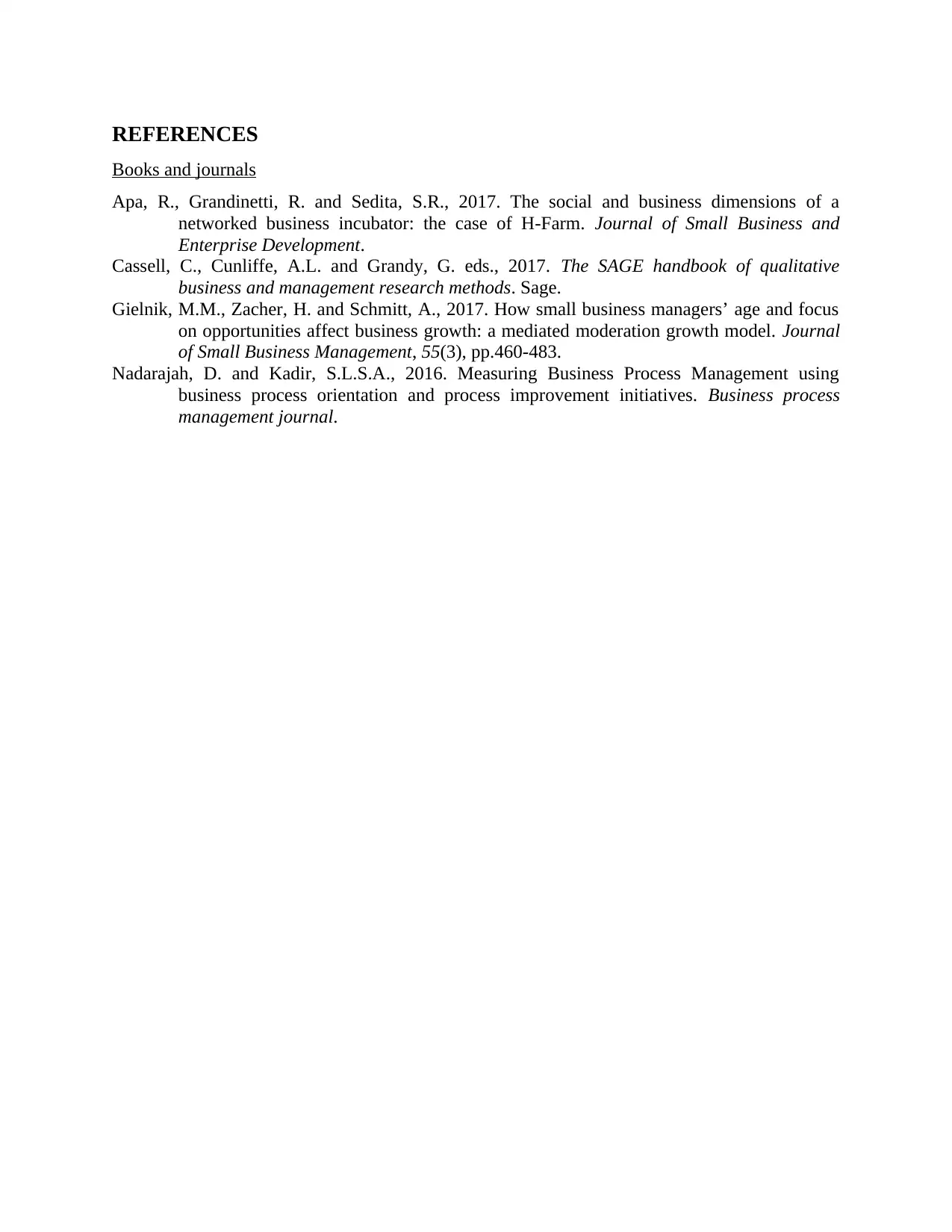
REFERENCES
Books and journals
Apa, R., Grandinetti, R. and Sedita, S.R., 2017. The social and business dimensions of a
networked business incubator: the case of H-Farm. Journal of Small Business and
Enterprise Development.
Cassell, C., Cunliffe, A.L. and Grandy, G. eds., 2017. The SAGE handbook of qualitative
business and management research methods. Sage.
Gielnik, M.M., Zacher, H. and Schmitt, A., 2017. How small business managers’ age and focus
on opportunities affect business growth: a mediated moderation growth model. Journal
of Small Business Management, 55(3), pp.460-483.
Nadarajah, D. and Kadir, S.L.S.A., 2016. Measuring Business Process Management using
business process orientation and process improvement initiatives. Business process
management journal.
Books and journals
Apa, R., Grandinetti, R. and Sedita, S.R., 2017. The social and business dimensions of a
networked business incubator: the case of H-Farm. Journal of Small Business and
Enterprise Development.
Cassell, C., Cunliffe, A.L. and Grandy, G. eds., 2017. The SAGE handbook of qualitative
business and management research methods. Sage.
Gielnik, M.M., Zacher, H. and Schmitt, A., 2017. How small business managers’ age and focus
on opportunities affect business growth: a mediated moderation growth model. Journal
of Small Business Management, 55(3), pp.460-483.
Nadarajah, D. and Kadir, S.L.S.A., 2016. Measuring Business Process Management using
business process orientation and process improvement initiatives. Business process
management journal.
1 out of 7
Related Documents
Your All-in-One AI-Powered Toolkit for Academic Success.
+13062052269
info@desklib.com
Available 24*7 on WhatsApp / Email
![[object Object]](/_next/static/media/star-bottom.7253800d.svg)
Unlock your academic potential
Copyright © 2020–2025 A2Z Services. All Rights Reserved. Developed and managed by ZUCOL.

